Today’s review will focus on the Supermicro H8SML-7F server motherboard. The single socket server segment is largely owned by the Intel Xeon E3-1200 series, however many web hosts utilize AMD’s socket AM3+ platform to provide low-cost dedicated servers. The Supermicro H8SML-7F is not just an AMD socket AM3+ server motherboard for the Opteron 3300 series (and Opteron 3200 / Opteron 3100 series before that), it is also a very well rounded mATX server motherboard. This is because Supermicro has added an onboard LSI SAS2308 controller to the motherboard. The LSI SAS2308 is a very fast SAS III 6.0gbps RAID controller/ HBA that offers features and performance similar to the LSI 9207-8e and LSI 9207-8i. More on this later. For the low-cost dedicated server segment, the H8SML-7F is a great piece of hardware as the LSI 9207-8i alone costs around $300. One of the biggest value propositions of this board is it allows dedicated server operators to provide a lower-cost upgrade path using AMD CPUs. For home users, one of the great features is the fact that it is an AM3+ motherboard with built-in IPMI 2.0 management, Intel NICs and an onboard SAS controller. Let’s take a look at the motherboard.
Test Configuration
For this test, we assumed a basic dedicated or cloud server platform, similar to what we use with the Intel Xeon E3 line. We used one setup to confirm that the system worked with standard consumer motherboards and another to provide parity to our standard test configurations.
- CPU: AMD Opteron 3380
- Motherboard: Supermicro H8SML-7F
- Memory: 16GB Kingston ECC 1600 CL11 DDR3 4x 4GB UDIMMs
- OS Drive: OCZ Vertex 4 256GB
- Enclosure: Norco RPC-4224
- Power Supply: Corsair AX750 750w 80Plus Gold PSU
- OS: Windows 8 Pro 64-bit, Ubuntu 12.04 Server
These should be fairly standard styles of Opteron 3300 series configurations. This is also very similar to the configuration used in our AMD Opteron 3380 review.
The Supermicro H8SML-7F
Utilizing a micro ATX (mATX) form factor, the Supermicro H8SML-7f is very compact. One can see that the server motherboard utilizes a standard socket AM3+ commonly found on desktop motherboards. That is important because it also means that one can use desktop coolers (depending on the application.) To do the initial setup test we used a very low cost $5.99 Cooler Master heatsink of unknown model number and it worked fine on the motherboard. Other big notes around the CPU area are five 4-pin PWM fan connectors and four DDR3 DIMM slots. The DDR3 DIMM slots accept unbuffered ECC DDR3 DIMMs. These UDIMMs can be up to 8GB in capacity for a maximum memory configuration of 32GB of ECC memory.
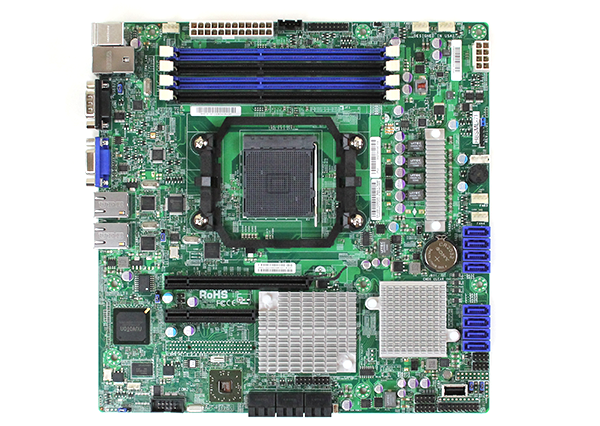
In terms of expansion, the Supermicro H8SML-7F has a PCIe x16 slot (x8 electrical) and a PCIe x8 slot (x4 electrical.) The AMD socket AM3+ platform with the AMD SR5650 / SP5100 chipset is PCIe 2.0 only. Although there are only two PCIe slots, for a majority of installations, it is unlikely they will even be used. This is because the Supermicro H8SML-7F has a RAID controller/ HBA already built-in.

Next to the internal USB Type-A port, one can see eight blue 7-pin SATA/ SAS connectors. These connectors are from the onboard LSI SAS2308 controller. Each one capable of connecting either SAS or SATA drives at 6.0gbps speeds. They sit at the rear edge of the motherboard for easy cabling. To add this feature via an expansion slot one would need to add a $300 controller so it is safe to say it makes up a significant part of the $399 motherboard’s BOM.
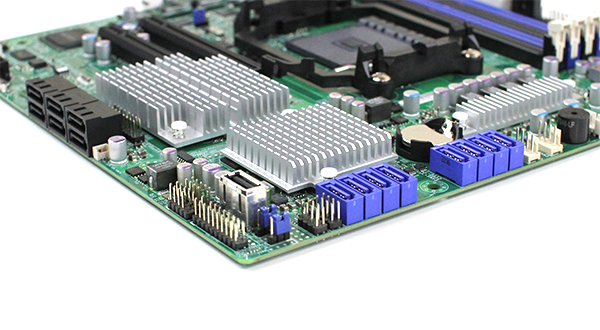
Along with the eight ports from the LSI SAS2308, the bottom edge of the motherboard has six right angle SATA connectors.These six ports run in SATA II 3.0gbps mode and are generally fast enough for most traditional hard drives. Combined with the LSI SAS2308 controller, that gives the Supermicro H8SML-7F capacity to control 14 hard drives or solid state drives directly from the motherboard.
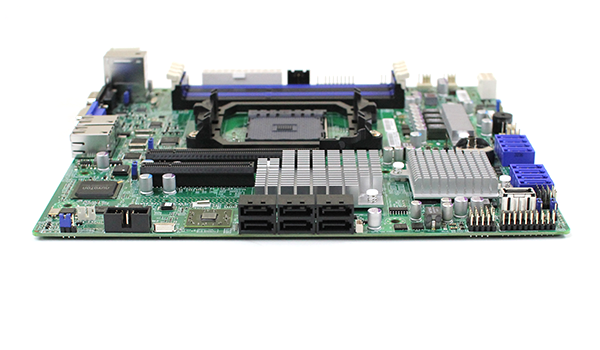
Looking at premium components, the Supermicro H8SML-7F motherboard also has dual Intel 82574L controllers onboard. Most consumer AMD socket AM3+ motherboards utilize inexpensive Realtek controllers. The Intel 82574L is more or less the de facto standard server Ethernet controller these days, so having one onboard is a great bonus because it increases compatibility with almost every operating system out there.
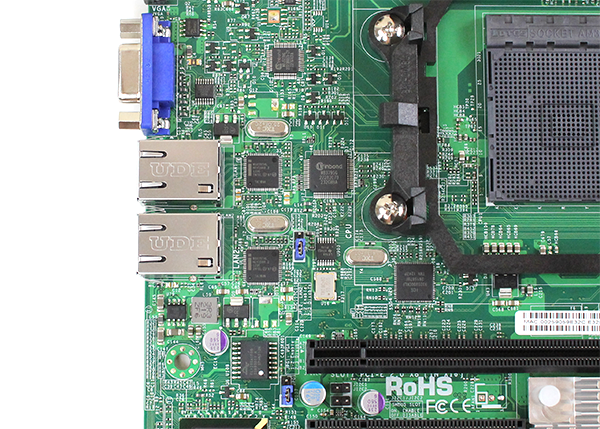
These controllers link to two RJ-45 connectors in the rear to provide dual gigabit Ethernet. The third RJ-45 port is an IPMI 2.0 management Ethernet port. Along with these network connections one can find standard PS/2 keyboard and mouse ports along with VGA and serial ports on the rear of the motherboard.
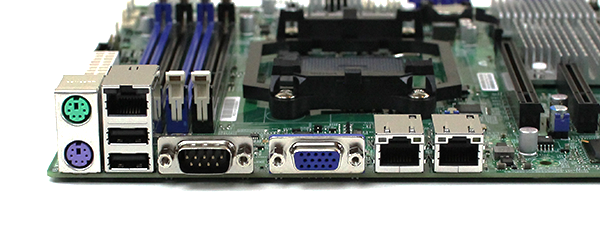
In terms of hardware, the Supermicro H8SML-7F has most of the components one might want on an AMD Opteron 3300 series server motherboard. The onboard components set the board apart from less expensive consumer boards used in some hosting market segments.
Supermicro IPMI Remote Management
Supermicro’s IPMI and KVM-over-IP as described a few times on this site, allows for a lot of deployment flexibility. Things such as fan speeds, chassis intrusion sensors, thermal sensors, and etc. can be monitored remotely. Alerts can be setup to notify the admins of issues. Beyond this, the Nuvoton BMC chip also allows for remote power control. You can do remote power up, power down, and reset of the server in the event that it becomes unresponsive. In fact, the test system has never had a keyboard, mouse, CD/DVD ROM, or monitor hooked up to it, even after multiple BIOS tweaks and operating system/ hypervisor installations.
Another important feature is the ability to remotely mount CD images and floppy images to the machine over the dedicated management Ethernet controller. This keeps maintenance traffic off of the primary Intel NICs. At the same time it removes the need for an optical disk to be connected to the Supermicro motherboard. Combined with the onboard USB 2.0 header, mounting OS installation or recovery images remotely is a very simple affair.
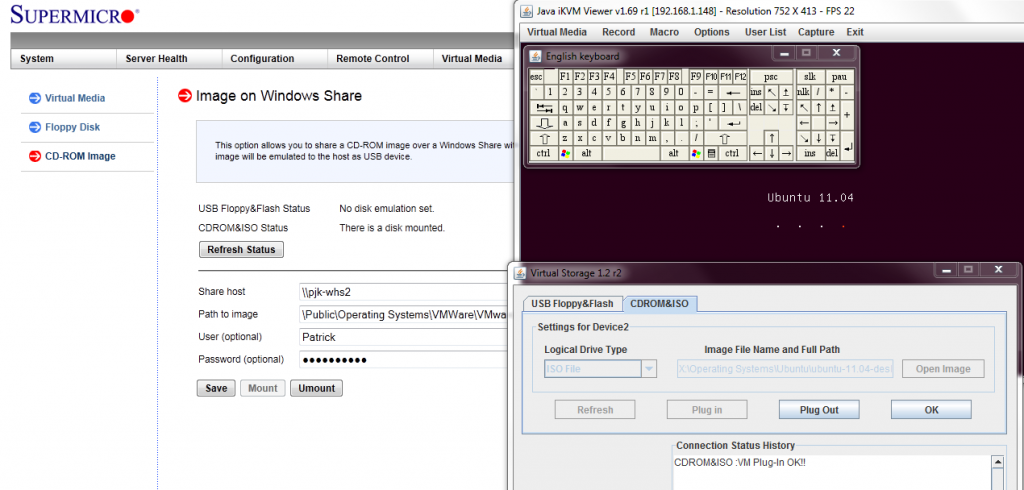
In combination with the baseboard level management features just described, KVM-over-IP features of the Supermicro board are not to be underestimated. One can log on to the server using a web browser with Java platform support to administer the server. Or one can go through Supermicro’s IPMIview software and have remote console capabilities, with mouse support included. Oftentimes, users opine that shell access is enough to troubleshoot. However this BMC level access to the remote system allows one to immediately see things such as a hung and incomplete boot process, frozen servers, as well as manage motherboard and add-in card BIOS remotely. I believe that the IPMI 2.0 features, including the KVM-over-IP features are essential for a server-class motherboard unless one has an external KVM-over-IP unit and a network addressable power source. For users with redundant PSUs, as will be the most common use case with this motherboard, remotely toggling on/ off multiple power supply ports across multiple PDUs can be difficult making the motherboard option preferred.
Conclusion
Overall, the Supermicro H8SML-7F provides many onbaord features. By integrating components directly on the motherboard, costs are lowered significantly. For the dedicated hosting market, this is a very strong contender for those customers who want a lot of storage connectivity on a socket AM3+ platform. Another advantage is that the motherboard can handle three generations of AMD architectures so there is a direct upgrade path for current customers. In the Opteron 3300 series and AMD socket AM3+ server motherboard market, this is one of the most cost effective solutions for higher-end configurations.





This board could be a good solution for small-scale SMB/high-end home ZFS builds, especially if you are considering using SSD volumes. Could you provide some power consumption measurements?
Besides the obvious SATA ports, it would be nice if the board came with SFF-8088 sockets. Does this controller support SAS expanders would be the huge question for me.
Is it possible to use the LSI in IT mode? (for ZFS) And how about IOMMU, is it possible to configure passthrough for the LSI controller in ESXi? That would really make this board interesting in an All-in-one server!
Pat, Pls consider this a third ZFS comment, and try to boot any solaris distro and let us know if the AM3+ SATA or SAS2308 ports are seen. perhaps: http://omnios.omniti.com/wiki.php/Installation
thanks!
Thanks for the feedback Will do the ZFS side in the next week or so. The system is looping through the new Linux benchmark suite at the moment
what is the benefit (other than heat/power consumption) of the Opteron 3380 verses AMD FX-8350 Eight-Core in this board?
Also what would be the smallest case, if you wanted to house all the drives externally, that you would recommend after doing your build.
I’m very interested in this board for building small ZFS servers (Solaris, FreeBSD, ZFS on Linux under RHEL, etc). One of SuperMIcro’s distributors told me that recent BIOS revisions allow this board to accept less-expensive and more powerful FX-series CPUs. This is no surprise, since the Opteron 3000 series are essentially re-branded Piledriver designs with locked multipliers. However, I’ve been unable to get SuperMicro to confirm:
1) Which FX-series CPUs are supported on this board? I’m most interested in the FX-6300, FX-8300, FX-8320 and FX-8350.
2) Is ECC memory fully supported with FX-series CPUs? (I see no reason why not, as the FX datasheets confirm ECC is supported and the memory controller should be exactly the same as the Opteron).
Can you confirm or test any of those CPUs and ECC work?
Great article. Many thanks!
My big question is, what etailer has these in stock? Newegg doesn’t and I’m starting to price out a replacement for the ESXi box I just setup at home (I want more than 2 cores & 8GB of ram and DDR2 is to expensive now).
ESXi and Solaris confirmation. Can also flash this controller like you can others. We had three in our lab. Do need to use an empty sbr for flashing.
ECC also working
Cool, thanks!
Hi Allan, are you running an FX CPU or Opteron? If FX, which one? Thanks!
Bought mine @ wiredzone.com for around $275. AMD FX-6300 confirmed to work, and using 2 x 8GB Kingston KVR13E9/8HM ECC 1333MHz memory. ESXi 5.1 functions on the AMD SP5100 provided SATA ports, but my storage volumes were very slow. ESXi will NOT recognize RAID 0 or 1 provided by the built-in Adaptec RAID controlled from BIOS – only sees the raw SATA devices. I did not try to create storage volumes on the LSI ports, but wanted to pass through the controller directly to a VM, so your milage may vary. VMware recommends a BBWC (battery backed write cache) disk controller for storage volumes, and disk I/O is slow without one. On the other hand, RHEL 6.4 runs great on the bare metal and disk throughput on the built in AMD SP5100 provided SATA ports is around 4x faster on Linux than on ESXi. The LSI SAS2308 controller is recognized by RHEL right out of the box and is very fast – no need to build/install 3rd party drivers. I’m running ZFS on Linux on 8 x 2TB SATA drives with no issues. Have fun!
I’m using this board in my home server (fileserver, virtualization and other things) and am quite happy with it. I’m running linux on it with a four disk raid 10 (and one system disk). The one great drawback in my opinion is the fan control.
Actually, I wanted to control my fans via software (set the pwm signal) to implement different thermal zones, but the sm support told me, this is not possible (yes, i tried beforehand and failed). All fans are controlled as one unit via the bios (and there are only four presets to choose from. No detailed settings are available).
The position of the eight SAS/SATA ports from the LSI controller are also a bit suboptimal, as they are partly blocking the airflow to the chipset heatsink, which can get really hot (in my opinion… touching it was nearly painfull). I constructed some kind of airduct, to circumvent this.
But all in all a nice board.
Mike, thanks for the info on the FX-6300. Has anyone been able to confirm if it works with FX-8320? Biggest concern is if the VRMs can handle the higher load since the 3380 is 65W while the FX-8320/8350 are 125W. 85W FX-6300 is probably safe.
The unofficial word is H8SML only support 95W TDP max CPUs and the 95W FX-6300 has been tested in lab. With the FX-6300 seen as low as $90 this is a great combination with ~$173 H8SML-iF. FYI, models with LSI SAS controller has (2) PCI-e slots while non-LSI have (3) PCI-e.